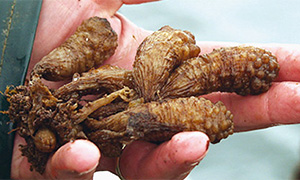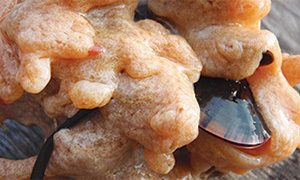Invasive Tunicates
Report it
If you think you have found an aquatic invasive species:
- do not return the species to the water
- take photos
- note:
- the exact location (GPS coordinates)
- the observation date
- identifying features
- contact us to report it
Learn about invasive tunicates, including types of tunicates, location, habitat, impacts and our response.
On this page
- Types of invasive tunicates
- Where is the group invasive?
- Distribution
- Habitat
- Impacts
- Response
- Photo gallery
- Related links
Types of invasive tunicates
Tunicates are small marine invertebrates that spend most of their lives attached to an underwater surface. They are named “tunicate” for their thick outer layer resembling a tunic. They are water-filled sacs that filter feed by drawing in and expelling water through tubular siphons. Several invasive species of tunicates threaten our waters. They can be spread by ocean currents but are mainly moved from place to place by human activities.
Tunicates can be either solitary or colonial. Both can reproduce sexually, producing free swimming larvae. Colonial tunicates can also form new colonies when pieces break off and drift to a new area and become attached there. Colonial tunicates form gelatinous mats or hanging lobes that may cover almost anything underwater. The colonies are made up of many individual organisms, called zooids, embedded in a common matrix, whereas, solitary tunicates operate as separate individuals. Though solitary tunicates grow individually they can form very dense groups.
Invasive solitary tunicates in Canada include:
- Clubbed Tunicate (Styela clava)
- European Sea Squirt (Ascidiella aspersa)
- Vase Tunicate (Ciona intestinalis)
Species of colonial invasive tunicates include:
- Compound Sea Squirt (Diplosoma listerianum)
- Golden Star Tunicate (Botryllus schlosseri)
- Pancake Batter Tunicate (Didemnum vexillum)
- Violet or Chain Tunicate (Botrylloides violaceus)
If you think you have seen an invasive tunicate, report it.
Where is the group invasive?
Invasive tunicates have been found in coastal waters of the Canadian Pacific and Atlantic Oceans.
Distribution
More information on the distribution ranges of each invasive tunicate species can be found following the links to their individual pages above.
Habitat
Tunicates are typically found:
- in sheltered areas and attached to:
- rocks
- other animals
- eelgrass or seaweeds
- on man-made structures, such as:
- ropes
- buoys
- anchors
- boats
- wharf pilings
- floating docks
- fishing gear
- aquaculture gear
Impacts
The presence of invasive tunicates can lead to several negative impacts on indigenous aquatic communities, the aquaculture industry and many other users of aquatic resources. The following are examples of potential impacts:
- may outcompete native organisms for food and space
- threatens aquaculture, fishing, and other coastal activities
- can increase drag on vessels, slowing them down and increasing fuel costs
- increases the weight of gear, causing work to be more demanding
- increases the operating costs for shellfish producers and processors
- may reduce size and condition of commercially raised species (e.g. mussels)
Response
We collaborate in on-going efforts to detect and control invasive tunicates with groups including academia, Indigenous Groups, and industry. Monitoring efforts allow for early detection of new invasive species and to determine the spread, establishment and spatial distribution of existing ones.
Photo gallery

Clubbed Tunicate

European Sea Squirt

Vase Tunicate

Compound Sea Squirt

Golden Star Tunicate

Violet Tunicate

Pancake Batter Tunicate

Solitary (left) vs Colonial tunicates (right)
Related links
- Monitoring invasive species using collectors
- Identification Booklet of marine species in Eastern Canada
- Aquatic Invasive Species Identification Booklet
- Monitoring the State of the St. Lawrence River
- Science advice from a risk assessment of five sessile tunicate species
- Marine Screening-Level Risk Assessment Protocol for Marine Non-Indigenous Species
- Surveys for Non-Indigenous Tunicate Species in Newfoundland, Canada (2006 to 2014)
- Biofouling Monitoring for Aquatic Invasive Species in Maritimes Region (2012 to 2015)
- Scientific Research on Tunicates
- Risk Assessment for Two Solitary and Three Colonial Tunicates in Both Atlantic and Pacific Canadian Waters
- Application of QBRAT for a Risk Assessment of the Invasive Tunicate Didemnum sp. in British Columbia
- Proceedings of the National Peer Review of the Risk Assessments of two solitary and three colonial Invasive Tunicates in both Atlantic and Pacific Canadian Waters; March 13-14, 2007
- Date modified: